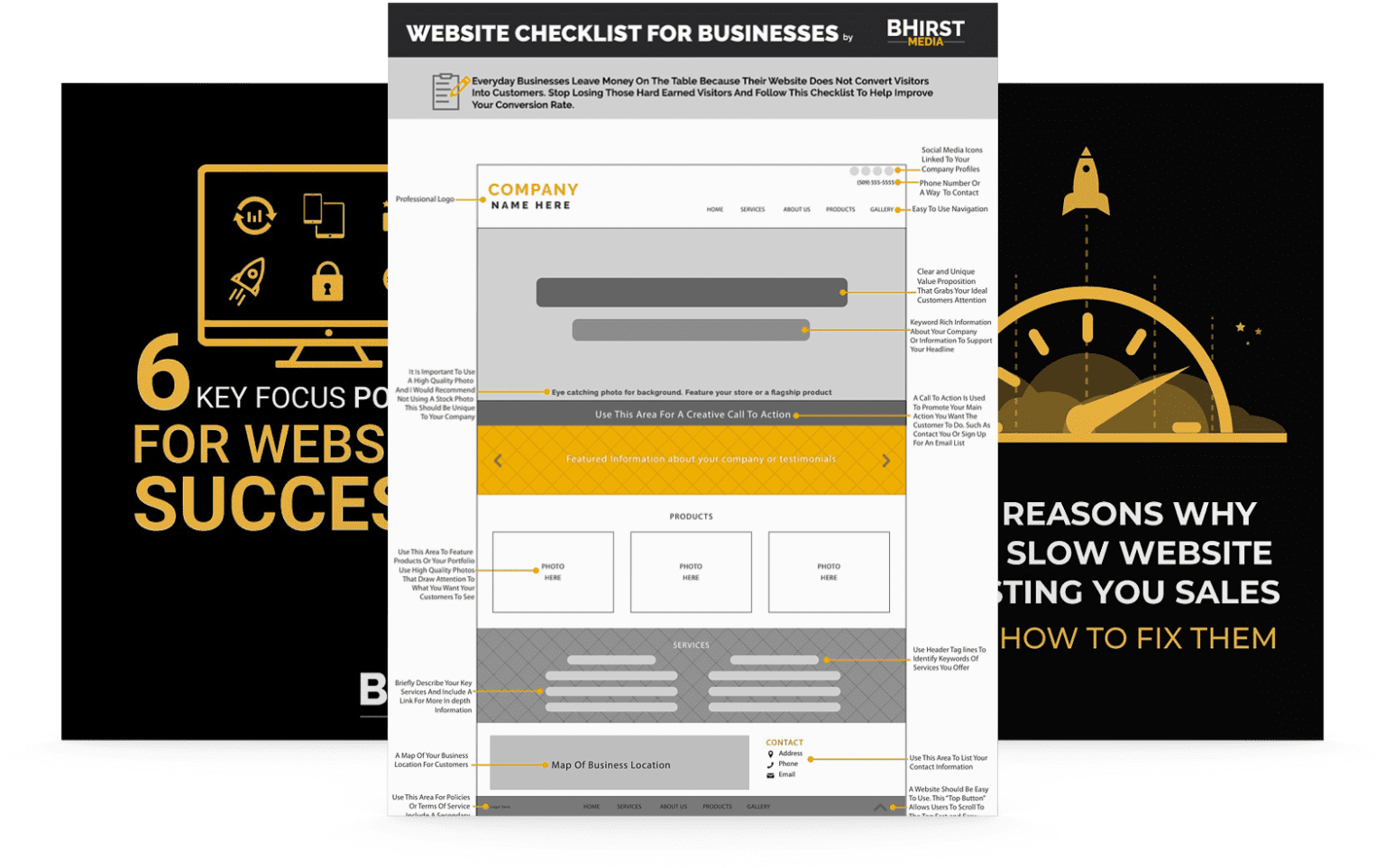
“How much will a website cost me?” It’s rarely a straightforward answer, especially in 2025’s digital landscape. While many business owners expect a simple price tag, the reality involves a complex web of expenses that extend far beyond the initial build.
For small business owners, understanding these costs isn’t just about budgeting—it’s about making strategic decisions that impact your company’s digital presence for years to come. The difference between a $3,000 website and a $10,000 one isn’t just price—it’s capability, scalability, and long-term value. Similarly, choosing between professional development and DIY solutions involves weighing immediate savings against substantial time investments that translate to real opportunity costs.
Website expenses in 2025 encompass everything from hosting and maintenance to content creation and accessibility compliance—with each component carrying both obvious and hidden costs. For healthcare providers, this might include HIPAA-compliant data handling systems, while retailers need robust e-commerce capabilities, and service businesses require seamless booking platforms. Whether you’re launching your first online presence or upgrading an existing site, this guide breaks down the true cost of business websites today, helping you allocate resources effectively and avoid expensive surprises across any industry.
Domain name registration and web hosting represent the fundamental building blocks of your online presence. In 2025, domain name costs remain relatively stable, typically ranging from $12 to $20 annually, whereas premium domains can cost upwards of $1,000, particularly for industry-specific terms like “insurance.com” or “legal.services.” Web hosting costs vary widely depending on needs, starting at $5-$25/month for shared hosting suitable for small service businesses to $150-$350/month for dedicated hosting essential for high-traffic e-commerce sites or healthcare portals handling sensitive patient data. Cloud-based solutions offering improved scalability range from $50-$200, providing flexibility for seasonal businesses like tourism companies or educational institutions with enrollment cycles.
Industry requirements often dictate hosting choices—financial services firms typically require enhanced security features, while media companies need robust content delivery networks to handle large files and streaming capabilities.
DIY website builders offer economical options, costing $15-$50/month, but impose design and functionality limitations that can restrict brand expression and customer experience. Professional design services for tailored solutions range from $1,500 for basic informational sites to $75,000+ for complex platforms with custom functionality, depending on your industry needs.
A restaurant might need a $2,500-$4,000 website with menu displays and reservation capabilities, while a real estate firm might invest $8,000-$15,000 for property listings and virtual tour integration. Manufacturing companies often require specialized product catalogs with technical specifications ($10,000-$20,000), and educational institutions typically need learning management integration costing $15,000-$30,000. The initial investment ensures alignment with business goals and long-term scalability, particularly as customer expectations continue to evolve in the digital marketplace.

Professional content creation is critical in 2025’s competitive digital landscape. Standard copywriting starts at $75-$250 per page, while specialized technical or industry-specific content for fields like healthcare, finance, or legal services ranges from $250-$500 per page. Professional photography packages range from $500-$2,500 depending on scope, with product photography for e-commerce requiring particular attention to detail.
Custom illustrations cost $250-$750 each, while informational videos start at $1,000 and can reach $5,000+ for professional productions. For example, dental practices often invest in educational videos explaining procedures ($1,500-$3,000 each), while manufacturing companies require detailed product demonstration videos ($2,000-$4,000). Investing in quality content significantly enhances brand credibility and user engagement—research shows websites with professional content experience 38% lower bounce rates and 29% higher conversion rates compared to those with generic materials.
Advanced capabilities add substantial costs but deliver essential functionality for modern businesses. E-commerce functions start at $2,000 for basic implementations and reach $25,000 for bespoke solutions with complex inventory management. A clothing retailer might spend $5,000-$10,000 for a comprehensive online store, while a wholesale distribution company might invest $15,000-$25,000 for B2B ordering capabilities.
Integrations with existing business systems vary widely: CRM connections cost $1,000-$2,500, email marketing tool integration ranges from $800-$1,500, and accounting software synchronization typically runs $1,500-$3,500. Healthcare providers implementing patient portal connections face costs of $3,000-$7,000 plus ongoing compliance expenses, while educational institutions connecting to student information systems might budget $4,000-$8,000. These integrations, while expensive, eliminate manual data transfer and streamline operations across departments.
While DIY builders like Squarespace, Wix, or Shopify may seem affordable at $15-$50/month, they entail substantial hidden time costs that business owners frequently underestimate. Setting up even a basic DIY website typically requires at least 60 hours for design, content creation, and functionality setup—translating into $6,000-$10,000 in opportunity costs based on average small business owner salary equivalents ($100-$175/hour).
Industry-specific challenges further complicate DIY approaches. Restaurants struggle with menu layouts and mobile optimization, professional service firms face difficulty creating sophisticated client journey pathways, and retailers often hit limitations with inventory management and shipping integrations. Beyond setup, ongoing maintenance demands 5-10 hours monthly for updates, content refreshes, and technical troubleshooting.
The learning curve for effective SEO implementation, security management, and performance optimization creates additional inefficiencies. One survey of small business owners found that 73% underestimated the time required for website management by at least 40%, with many eventually outsourcing tasks they initially planned to handle internally.
Professionally developed websites range from $1,500 for basic informational sites to $75,000+ for complex enterprise solutions, with costs customized to specific business requirements and technical complexity. Though the upfront investment is higher, professionally built sites deliver substantial time savings, enhanced functionality, and improved user experiences that directly impact business outcomes.
A standard small business website with content management capabilities typically costs $3,000-$8,000, while service businesses requiring appointment booking functionality might budget $8,000-$15,000. E-commerce sites start at $10,000 for basic implementations and can exceed $50,000 for multi-channel retail platforms with inventory synchronization and customer account features.
The professional development process includes critical components often missing from DIY approaches: comprehensive business requirement analysis, competitive positioning strategy, user experience design, mobile responsiveness engineering, and cross-browser testing. For regulated industries like healthcare or financial services, developers also implement necessary compliance measures and documentation, reducing potential legal exposure.
When projecting expenses over a five-year period, the financial comparison between DIY and professional options becomes more nuanced. DIY websites appear more economical at first glance, with platform costs of $2,000-$6,500 over five years depending on the service level. However, factoring in the business owner’s time commitment at standard billable rates brings the true five-year cost to $35,000-$60,000 when including initial setup and ongoing management.
Professionally developed sites, despite higher initial investment, often prove more cost-effective in the long run. The five-year total typically ranges from $17,000-$45,000 including initial development, hosting, maintenance, and periodic updates. This calculation reveals that after approximately 18-24 months, professional solutions frequently become more economical than DIY approaches when accounting for the value of time.
The ROI difference becomes even more pronounced when considering performance metrics. Professional sites typically load 30-40% faster, achieve 15-25% higher conversion rates, and maintain better search engine positioning—directly impacting revenue potential and customer acquisition costs across all business categories.
Initial website expenses encompass several critical components that form the foundation of your digital presence. Design and development costs represent the largest portion, ranging from $1,500 for simple informational sites to $75,000+ for custom platforms with advanced functionality. For context, a typical local law firm might invest $4,000-$7,000 in initial development, while a multi-location retail business with e-commerce needs might budget $15,000-$30,000.
Content creation constitutes another significant upfront investment, typically ranging from $1,000-$15,000 depending on site complexity and industry requirements. This includes professional copywriting ($75-$250 per page), photography ($500-$2,500), and initial video production if needed ($1,000-$5,000 per video). Healthcare providers often invest more heavily in educational content, while manufacturing companies require detailed product specifications and technical documentation.
Basic technical setup adds $500-$2,500 for domain configuration, SSL certificate implementation, and initial security measures. Industry-specific requirements may increase these costs, such as HIPAA compliance setup for healthcare ($2,000-$5,000) or PCI compliance for e-commerce ($1,500-$3,000).

Regular maintenance represents a non-negotiable recurring expense for business websites in 2025. Comprehensive maintenance plans typically cost $100-$350 per month, covering critical services like security updates, plugin management, performance monitoring, and technical troubleshooting. For complex e-commerce sites or membership platforms, these costs may reach $500+ monthly.
Hosting expenses continue indefinitely, ranging from $5-$25 monthly for basic shared hosting to $100-$350 for dedicated servers required by high-traffic websites or those handling sensitive information. Content delivery networks add $20-$200 monthly for improved global performance, particularly important for businesses with international audiences.
Domain name renewal adds approximately $12-$20 annually, while SSL certificate renewals cost $50-$200 yearly depending on the security level. Email hosting for business domains typically adds $5-$15 per user monthly, with higher costs for advanced security features often required in financial, legal, and healthcare industries.
Content updates and SEO management represent significant ongoing investments, with businesses typically spending $500-$5,000 monthly for continued visibility and engagement. Regular analytics review and conversion optimization, though sometimes overlooked, deliver some of the highest ROI among all recurring expenses.
Websites require periodic redesigns every 3-5 years to maintain competitive positioning, adapt to changing user expectations, and incorporate technological advancements. These refreshes typically cost 50-75% of the original development budget ($3,000-$25,000 depending on site complexity), with higher-end costs for businesses needing to migrate platforms or significantly expand functionality.
Strategic future-proofing investments often prove cost-effective despite higher initial expenses. Implementing scalable architecture from the beginning can save 30-40% on expansion costs later, while selecting platforms with strong developer communities and regular updates minimizes technical debt accumulation. For example, a growing retail business might invest an additional $3,000-$5,000 initially for scalable inventory management that eliminates the need for a $15,000-$20,000 system replacement within two years.
Platform migration costs—often necessitated by outgrowing existing solutions—typically range from $5,000-$25,000 depending on complexity, with data transfer representing the most challenging aspect. This is particularly relevant for businesses using entry-level solutions that later require enterprise-grade functionality, such as professional service firms moving from basic appointment booking to comprehensive client management systems.
DIY website creation and management impose substantial opportunity costs that remain invisible on financial statements but significantly impact business growth. Initial DIY website setup typically requires 60-100 hours of concentrated effort, representing $6,000-$10,500 in opportunity cost based on average small business owner compensation rates. For specialized professionals like healthcare providers, attorneys, or consultants with higher billable rates ($200-$400/hour), these opportunity costs can exceed $20,000-$40,000.
Ongoing management demands 5-15 hours monthly for basic maintenance and content updates, translating to 60-180 hours annually ($6,000-$21,000 in opportunity cost). This time allocation diverts focus from core business activities like client acquisition, service delivery, or strategic planning—areas typically generating substantially higher returns than website management.
The expertise gap creates additional inefficiencies, with business owners spending 30-50% more time than professionals would require for equivalent tasks. Learning curves for technical aspects like SEO implementation, security management, and performance optimization further diminish productivity, particularly in specialized fields like healthcare where proper handling of sensitive information requires additional knowledge.
Website security has evolved from a technical consideration to a business imperative with financial implications. Basic security measures cost $200-$500 annually, while comprehensive protection including malware scanning, firewall implementation, and regular security audits ranges from $1,000-$3,000 yearly. For e-commerce businesses handling payment information or healthcare providers managing patient data, these costs typically double.
Accessibility compliance has become increasingly critical, with ADA-related website lawsuits increasing by over 300% since 2018. Initial accessibility remediation typically costs $2,000-$5,000 for small-to-medium websites, with ongoing compliance monitoring adding $500-$1,500 annually. Educational institutions face particularly stringent requirements, while retail businesses with frequent content updates need regular accessibility audits.
Privacy regulations like GDPR, CCPA, and state-specific laws impose additional compliance requirements. Policy development and implementation costs range from $1,000-$3,000 initially, with ongoing compliance management adding $1,500-$4,000 annually for businesses collecting significant customer data. These expenses are particularly relevant for financial services, healthcare, and e-commerce businesses, where data handling practices face greater scrutiny.
Neglecting preventive maintenance frequently results in costly emergency interventions. While regular maintenance plans cost $1,200-$4,200 annually, emergency fixes for compromised websites typically start at $1,000-$3,000 per incident, with complex recovery scenarios reaching $5,000-$10,000. Healthcare providers and financial institutions face the highest remediation costs due to regulatory reporting requirements following security incidents.
Business downtime represents another substantial hidden cost, with websites generating leads or sales potentially losing hundreds to thousands of dollars hourly during outages. For example, an e-commerce site averaging $50,000 monthly might lose $70+ per hour during business hours, while a professional services firm could miss multiple $200+ lead opportunities during extended downtime.
Outdated plugins, themes, or core systems create accumulating technical debt that eventually requires costly overhauls. Websites neglecting regular updates for 12+ months typically require remediation services costing $2,000-$8,000 depending on complexity, compared to monthly maintenance plans averaging $100-$350. This pattern appears consistently across industries, though content-heavy sites like publications and educational resources typically face higher remediation costs due to the volume of affected materials.
Implementing a phased development approach allows businesses to distribute costs over time while prioritizing the most impactful elements. Starting with a minimum viable website focused on core business needs ($2,000-$5,000) creates immediate online presence, with functionality expansions planned quarterly or semi-annually. For example, a professional services firm might begin with service information and contact capabilities, later adding appointment scheduling, client portals, and resource libraries.
Identifying true requirements versus “nice-to-have” features can reduce initial costs by 30-40% without compromising essential functionality. A structured discovery process identifying mission-critical elements helps prioritize development resources—restaurants need online ordering more urgently than staff bios, while manufacturers must showcase products before publishing company history.
Building modular architecture that supports future expansion costs slightly more initially (10-15%) but eliminates expensive rebuilds later. This approach proves particularly valuable for early-stage businesses expecting significant growth, allowing them to add specialized functionality like membership systems, advanced search capabilities, or inventory management when revenue justifies the expansion.
Open-source platforms like WordPress power over 40% of websites globally, offering substantial cost advantages over proprietary solutions. While custom development on proprietary platforms might range from $15,000-$50,000+, equivalent WordPress implementations typically cost $5,000-$20,000 while maintaining flexibility for future modifications. This approach works especially well for service businesses, local retailers, and professional practices needing custom design without complex proprietary functionality.
Leveraging existing components and pre-built solutions significantly reduces development time and costs. Premium themes ($50-$300) provide professional design frameworks, while established plugins ($50-$500 annually) offer tested functionality rather than custom-coded solutions that might cost $2,000-$5,000 each. E-commerce businesses can particularly benefit from existing payment processing integrations, while healthcare providers can utilize established appointment systems rather than building proprietary solutions.
Strategic use of SaaS integrations (Software as a Service) allows businesses to incorporate sophisticated functionality without custom development costs. Third-party booking systems, CRM platforms, and marketing automation tools typically cost $20-$200 monthly but replace development expenses of $3,000-$15,000 for equivalent custom solutions. Educational institutions often leverage this approach for event management, while professional services firms utilize it for client interaction portals.
Combining professional content frameworks with internal contributions creates cost-efficient, high-quality results. Having professionals develop content templates, style guides, and key landing pages ($2,000-$5,000) provides the structure for internal teams to create supporting content following established patterns. This hybrid approach typically reduces content creation costs by 40-60% while maintaining consistency and quality.
Prioritizing high-impact content pages for professional development while handling secondary content internally optimizes investment. For example, a manufacturing company might invest in professional product descriptions and technical specifications while producing company news internally, or a healthcare practice might professionally develop treatment information while managing staff profiles in-house.
Content repurposing strategies maximize return on existing materials. Professional services firms can transform client presentations into website resources, retailers can adapt product photography across multiple channels, and educational institutions can convert instructional materials into valuable online content. This approach typically reduces content creation costs by 30-50% compared to developing all materials specifically for web use.

Lead generation metrics provide concrete measurements for service-based businesses evaluating website effectiveness. Professional websites typically generate 30-50% more qualified leads than DIY alternatives due to improved user experience, clear conversion pathways, and strategic calls-to-action. For example, a financial advisory firm investing $8,000 in professional development might secure 5-10 additional qualified leads monthly (worth $2,000-$5,000 in potential business), recovering costs within months.
E-commerce conversion rates directly correlate with website quality and functionality. Professionally designed online stores typically achieve conversion rates 25-40% higher than DIY alternatives, while also increasing average order values by 15-30% through strategic product presentation and checkout optimization. A retail business generating $25,000 monthly might see a $5,000-$10,000 monthly revenue increase after a $15,000 professional redesign—delivering full ROI within 2-3 months.
Customer retention metrics often show the most dramatic improvements, with professionally developed websites increasing repeat business by 20-40% across industries. For subscription-based businesses, this translates directly to lifetime customer value; for service providers, it manifests as increased referrals and expanded services. Healthcare practices typically see patient retention improvements of 15-25% after implementing patient portals and educational resources, while professional service firms experience similar gains through client resource centers.
Professional website development delivers accelerated search ranking improvements, with properly structured sites typically achieving first-page positioning 30-50% faster than DIY alternatives. This translates directly to reduced customer acquisition costs—businesses ranking organically for competitive terms save thousands monthly on paid advertising while generating higher-quality leads. For example, a specialized manufacturing firm ranking for industry-specific terms might generate 25-40 qualified leads monthly from search traffic, equivalent to $5,000-$8,000 in paid advertising value.
Long-term scalability represents a significant but often overlooked ROI factor. Professionally developed websites typically accommodate 3-5 years of business growth without major rebuilds, compared to 1-2 years for DIY solutions. This extended lifecycle effectively amortizes the initial investment over a longer period—a $10,000 professional solution lasting four years costs $2,500 annually, while a $3,000 DIY solution requiring replacement after two years costs $1,500 annually plus significant transition expenses.
Technology depreciation considerations affect financial planning for website investments. While physical assets typically lose value over time, properly maintained websites often appreciate in functional value through regular updates and content expansion. Viewing website expenses through this lens—as appreciating assets rather than sunk costs—provides a more accurate framework for ROI calculations. This perspective is particularly relevant for knowledge-based businesses like legal firms, consultancies, and educational institutions whose digital presence becomes increasingly valuable as content libraries expand.
Website investments represent far more than technical expenditures—they’re strategic business decisions with far-reaching implications for customer acquisition, operational efficiency, and competitive positioning. The most successful businesses approach website budgeting holistically, balancing immediate financial constraints with long-term growth objectives and recognizing that digital presence directly impacts brand perception and market opportunities.
The cost disparities between DIY and professional solutions reflect fundamental differences in capability, scalability, and time efficiency rather than simple price variations. When factoring the full spectrum of expenses—including opportunity costs, ongoing maintenance, security requirements, and inevitable technical evolution—professional development frequently delivers superior returns despite higher initial investment. This proves especially true for businesses where digital presence directly influences revenue generation, such as e-commerce retailers, service providers with online booking, and knowledge-based professionals establishing expertise.
Looking toward the future, website investments will increasingly focus on personalization capabilities, seamless cross-platform experiences, and AI-powered customer interactions. Businesses that establish robust digital foundations today while building flexible, scalable systems will gain significant advantages as these technologies mature. Whether through enhanced customer insights, automated service delivery, or intelligent content adaptation, tomorrow’s market leaders will leverage their digital infrastructure as a competitive differentiator—making thoughtful website investments today an essential component of future-focused business strategy.
